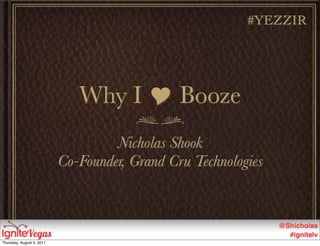Nicholas Shook: Why I Love Booze
- 1. #YEZZIR Why I ’üÖ Booze Nicholas Shook Co-Founder, Grand Cru Technologies Thursday, August 4, 2011
- 2. Taking the ’¼ürst sip 1. Mouth: alcohol enters the body. 2. Stomach: some alcohol gets into the bloodstream in the stomach, but most goes on to the small intestine. 3. Small Intestine: alcohol enters the bloodstream through the walls of the small intestine. 4. Heart: pumps alcohol throughout the body. 5. Brain: alcohol reaches the brain. 6. Liver: alcohol is oxidized by the liver at a rate of about 0.5 oz per hour. 7. Alcohol is converted into water, carbon dioxide and energy. Source: University of Washington 40-50 Proof + Empty Stomach = Drunk Faster Source: ForCon Thursday, August 4, 2011
- 3. Tangent: ŌĆ£Asian GlowŌĆØ aka ŌĆ£Alcohol Flush SyndromeŌĆØ Acetaldehyde Dehydrogenases Acetaldehyde Moral: Embrace the Glow! Thursday, August 4, 2011
- 4. Why alcohol induces tipsyness Answer to a question asked by a 13 year old: Alcohol is a Depressant, but does not kill brain cells! (unless you inject everclear into your blood) Source: Lifehacker Thursday, August 4, 2011
- 5. FeelinŌĆÖ Myself 100 Uh-Oh 80 Happiness 60 40 20 0 1 2 3 4 5 6 7 8 Drinks Consumed Thursday, August 4, 2011
- 6. Dealing with the Hangover Step 1: PUKE! Step 2: Replenish Thursday, August 4, 2011
- 7. Everyone: I ’üÖ Booze Thursday, August 4, 2011
- 8. U.S. (drinking) Alcohol Industry WhatŌĆÖs ordered at the bar Suppliers sold $57.6 B Beer Wine Spirits Source: The Distilled Spirits Council 33% Restaurants sold $110 B Source: Beverage Information Group 55% 12% 35% order Booze while dining Source: Technomic Source: The NPD Group Thursday, August 4, 2011
- 9. Wine Wine Consumption 6% 800 700.5 706.2 716.8 26% 673.4 Millions of Gallons 600 651.3 614.1 637.4 583.8 400 68% 200 0 2002 2003 2004 2005 2006 2007 2008 2009 California Imported Other States Thursday, August 4, 2011
- 10. How Wine is Made Growth Fermentation Aging Bottling Thursday, August 4, 2011
- 11. Categorizing Wine Varietal Region (varietal implicit) Winemaker Winemaker Region Thursday, August 4, 2011
- 12. Wines to AvoidŌĆ” Look of Disgust Thursday, August 4, 2011
- 13. Beer ŌĆ£Beer is proof that God loves us and wants us to be happyŌĆØ Benjamin Franklin P.S. International Beer Day is Friday! Thursday, August 4, 2011
- 14. GettinŌĆÖ Crafty 0% 25% 50% 75% 100% Anheuser-Busch MillerCoors Crown Imports Heineken USA 49.3% 30.2% 8.5% Pabst Brewing Company Craft Source: Beer Handbook 2010 H.R. 4278 7.2% Volume Get rid of Excise Tax Source: Brewers Association for less than 6M Barrels Thursday, August 4, 2011
- 15. Categorizing Beer Ale Lager Brewed without Hops Brewed with Hops Imperial Stout Pilsner Pale Ale Bock Brown Ale American Lager Belgian Ale Helles Porter Dunkel Thursday, August 4, 2011
- 16. Spirits and Mixology People are ordering more drinks Cocktail share up .4% Consumers desire premium spirits Revenue is up 11% Vodka is most consumed, Whiskey is growing Vodka = 33% of market; Whiskey grew 8.1% Thursday, August 4, 2011
- 17. Liquor Trends Whiskey Vodka Tequila 4.4% 5.0% 4.0% 5.1% 0.9% 1.8% Gin Rum Brandy Source: Distilled Spirits Council of the United States Thursday, August 4, 2011
- 18. Some Vegas Cocktails to Try Chandelier Bar, Cosmopolitan Julian Serrano, Aria Hash House a go go Double Helix Thursday, August 4, 2011
- 19. Conclusion If you drink, try everything! DonŌĆÖt drink too much. If you do drink too much, try some pho. If you donŌĆÖt drink, now is the time to start. DO NOT SHOW THIS TO CHILDREN Thursday, August 4, 2011
- 20. Thanks! and now for a toast... Thursday, August 4, 2011













































































